‘Who has not heard of the Vale of Cashmere,
With its roses the brightest that earth ever gave?…..
Then the sounds from the Lake, the low whispering in boats,
As they shoot through the moonlight…’
Whether it’s to experience the earthly paradise so lyrically described in Thomas Moore’s 1817 poems, or to relive the idyllic houseboat holidays captured in the black and white photos of previous generations – or something in between – Kashmir is high on many people’s bucket lists. But, given its dramatic location, actually arriving there requires a certain amount of persistence, avoiding unpredictable earthquakes (2005), floods (2014), and, as followers of government travel advice know only too well, outbreaks of military hostilities.
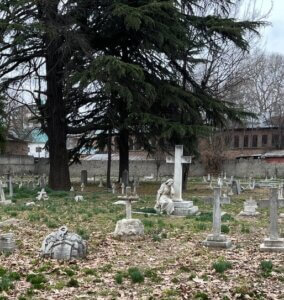
A group of European graves, including those of Maisie Broadway (1901) and Mabel Ellen Cunningham (1904).
(Photo: A Whitehead)
BACSA member Andrew Whitehead, writer and broadcaster, paid a quick visit to Sheikh Bagh Cemetery, Srinagar, before the current conflict erupted:
‘This month (March 2025), I was able to have a brief stroll around the Christian cemetery at Sheikh Bagh in the heart of Srinagar. For a century until the early 1950s, Kashmir had a small but significant European community. And this is where many of them are buried.
There is a new perimeter fence around the graveyard, but as we walked past I noticed that the gate was ajar. I popped in and took a few photos…
The older part of the cemetery, further away from the gate, has mostly European graves. The part closer to the gate seems mainly to be for the burial of Indian Christians.
Much of the damage caused by the terrible floods of 2014 had been made good – thanks to renovation work supported by the British Association for Cemeteries in South Asia. The graveyard is a little bare, but well tended and secure’.
Andrew Whitehead, March 2025.
A full account of Andrew’s visit, including photos of several graves dating from 1901-2008, is available here, in his personal blog.
Shaded by majestic chinar trees and bordered by the Zabarwan hills, Sheikh Bagh Cemetery became, as the late Eileen Hewson (BACSA Area Representative in Kashmir for many years), wrote: ‘the last resting place for many explorers, statesmen, missionaries and the British who preferred to ‘Stay on’ rather than return to an uncertain life in England’.
The cemetery is one of the locations visited in ‘A Promenade Along the Bund – Colonial Heritage Walk’, a series of five Walks curated by the Kashmir Chapter of INTACH (Indian National Trust for Art and Cultural Heritage), which aim to delve into ‘the history, architecture and culture of Srinagar’s urban landscape’. (Click here for further details).
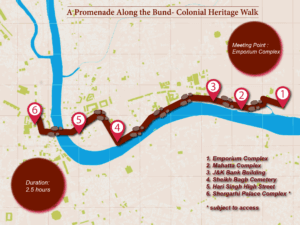
One of the earliest graves is that of Dr William Jackson Elmslie, the son of an Aberdeen shoemaker, who established the region’s first Christian medical mission in 1865. He compiled the first Kashmiri/English dictionary; wrote several letters to the Maharajah complaining about the government’s careless attitude to the cholera epidemic, and died, aged 40, of a recurring heart problem in 1872.
During a smallpox epidemic in 1892, Dr Arthur Neve, one of Elmslie’s successors, refused to leave his post, ultimately succumbing to exhaustion and illness. He, too, lies in Sheikh Bagh.
The grave of Col Sydney Drumond Turnbull, who had retired from 15th Bengal Lancers when he died, aged 56, in 1911, from ‘wounds received in an encounter with a leopard’, reminds us of a different type of Himalayan risk.
Sheikh Bagh Cemetery also became the place for commemorating people who had died while working, or travelling, further afield in the more inhospitable regions of Kashmir.
In her 2002 booklet Himalayan Headstones from Ladakh, Kashmir (available through the BACSA shop), Eileen Hewson mentions two such people: Captain James Palladio Basevi and Richard Edward Genge.
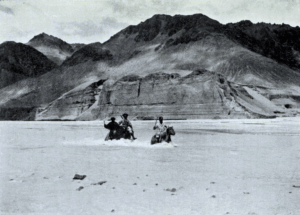
(Photo: Scottish Geographical Magazine, 1909)
Captain James P Basevi, the son of George Basevi, the architect who designed the Fitzwilliam Museum, at Cambridge, was a relative of Benjamin Disraeli (through the marriage of his aunt Miriam (‘Maria’) Basevi to the latter’s father, Isaac Disraeli). An army engineer, he served as Deputy Superintendent of the Great Trigonometrical Survey of India.
After crossing the Takalung Pass (18,000’), the Mori Pass (15,500’) and the Marsimik La Pass (18,000’; currently the ‘highest motorable pass in the world‘ – according to the Indian Army sign at the summit), Basevi died in 1871, aged 39, while carrying out surveying duties in the Chang Chenmo Valley, near Kiamo. His companions, not wishing to leave him in this ‘lonely place where nothing moved except the wind’, brought his remains back to Srinagar for burial.

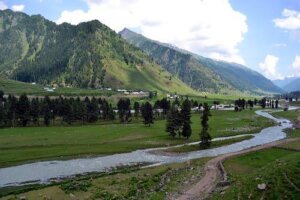
(Photo: sauood)
Richard Genge, a 24-year old Army Surgeon stationed at Multan, was killed in the Upper Warwan valley (noted for steep slopes and heavy snowfalls) in 1888. Richard and his party were camping overnight at 15,000’, on a glacier near the Yaurangshan Pass, when the entire group ‘including the porters’ were buried by an avalanche. Richard’s body was later recovered, and interred at Shaikh Bagh Cemetery.

(Photo: gul791)
The appeal of the mountains continued to run deep. Another memorial tablet at Sheikh Bagh commemorates Matthew Alexander Forbes, of St John’s College, Cambridge, who ‘was lost’, aged 22, in 1938, on Nanga Parbat – at 26,658’ the 9th highest mountain in the world, and ‘the western anchor of the Himalayas’.
(Situated in the present-day District of Gilgit-Baltistan in Pakistan-administered Kashmir, Nanga Parbat was first summited in 1953, by Hermann Buhl).
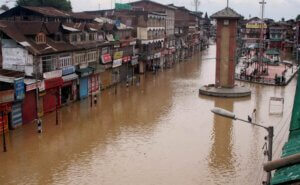
The 2014 floods wreaked havoc in Srinagar, and severely damaged parts of the cemetery. It is reassuring to read in Shereen Naman’s recent article on the Outlook.India website that ‘restoration efforts, spearheaded by the British Association for Cemeteries in South Asia (BACSA) and supported by local volunteers, have helped reclaim this historic place. Simple fencing, repaired headstones, and careful landscaping have returned a measure of dignity to the site’.
Hopefully this local support will ensure that Sheikh Bagh Cemetery continues to retain its significance in the built heritage of Kashmir for some time to come.
Rachel Magowan
*********************************************************************************
Diary Dates
BACSA Newsletter readers, family and friends may be interested in the following events:
| Date / Time | Event | Place |
| Thursday 22 May 2025 – Sunday 19 October 2025 | Ancient India – Living Traditions This new exhibition explores the origin of Hindu, Jain and Buddhist sacred art in the ancient and powerful nature spirits of India, and the spread of this art beyond the subcontinent. | British Museum, Great Russell Street, London WC1B 3DG Click here for further details, and to make a booking. |
| Saturday 28 Jun 2025, 10:00-16:30 | FIBIS (Families in British India Society) Open Meeting and Annual General Meeting | Union Jack Club, Sandell Street, London SE1 8UJ. Click here to register for this free event. |
| Monday 7 Jul 2025, 5:00pm for 6:00pm | ‘A Slashing Onslaught – Sir Charles Napier in India’ BIHT (The British in India Historical Trust) Lecture by Prof Peter Stanley | The East India Club, 16 St James’s Square, London SW1Y 4LH. Click here for further details, and to make a booking. |
| Wednesday 16 Jul 2025, 6:00pm | ‘Unfolding the Story of the abandoned Sheikhupura Fort: From a Haveli and a Royal Hunting Palace of the Mughals, to a British prison for the Sikh Maharani’ Commonwealth Heritage Forum Lecture in the series ‘Lost/Abandoned Places across the Commonwealth‘ by Saba Samee | Zoom lecture, free. Click here for further details, and zoom joining instructions. |
| Thursday 31 Jul 2025, 6:00pm for 6:30pm | ‘The Narinda Cemetery of Old Dacca’ Lecture by BACSA Executive Committee Members Charles Greig and Rosie Llewellyn-Jones | The East India Club, 16 St James’s Square, London SW1Y 4LH. Click Events to register and book tickets. |
| Sunday 5 Oct 2025 – Friday 17 Oct 2025 | British India: The East India Company & Mutiny Tour A 13-day tour in India led by Dr Rosie Llewellyn-Jones | Delhi, Meerut, Lucknow, Cawnpore, Serampore, Calcutta. Click here (or ring 020-8901-7320) for further details. |
| Thursday 16 Oct 2025, 11:30am | BACSA General Meeting (Members only) | Union Jack Club, Sandell Street, London SE1 8UJ. Further details (including registration instructions) will be published nearer the date. |
| Sunday 26 Oct 2025 | 150th anniversary of CSI Christ Church, Salem to include ‘Holy Communion Service, a Congregation feast and a concluding ceremony’. All are welcome to attend the church’s sesquicentennial celebrations – including descendants of former congregation members. | CSI Christ Church, Fort Road, Salem, Tamil Nadu, India. For further details, please contact: ‘csichurchsalem@gmail.com‘. |
****************************************************************************************
(Suggestions for BACSA website news items, volunteering opportunities and diary entries, are always welcome – please send them to ‘comms@bacsa.org.uk’.)
